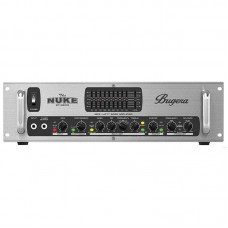آمپلی فایر گیتار باس بوگرا - Bugera Bass Guitar Amplifier
آمپلی فایر گیتار باس Bass Guitar Amplifier
آمپلی فایر گیتار باس دستگاهی برای تقویت صدای گیتار باس است. این دستگاه با استفاده از انرژی الکتریکی، سیگنال خروجی گیتار باس را به صدا تبدیل می کند. به طور معمول، یک آمپلی فایر گیتار باس از یک پری آمپلی فایر، کنترل های تقویت کننده صدا ، یک پاور آمپلی فایر و یک یا چند بلندگو (درایور) در یک کابینت تشکیل می شود. آمپلی فایر گیتار باس دارای ویژگی های مشترکی با آمپلی فایر گیتار میباشد اما بدلیل چالش های خاصی که در تولید صدای با فرکانس پایین وجود دارد، این نوع آمپلیفایر از انواع دیگر سیستم های تقویتی متمایز است. این تمایز در طراحی بلندگوها ، پری آمپلی فایر و آمپلی فایر و طراحی و اندازه کابینت تأثیر می گذارد. کابینت آمپلی فایر گیتار باس معمولا تعداد بیشتری بلندگو و ابعاد بزرگتری نسبت به آمپلی فایر سایر سازها دارد. همچنین خود بلندگوها نیز باید بقدر کافی قدرتمند باشند تا بتوانند با سطوح بالاتری از انرژی تعامل داشته و صدای بم را با قدرت مناسب تولید کنند.
نوازندگان گیتار باس جز (Jazz) اولین نوازندگانی بودند که به دنبال روشی برای افزایش صدای ساز خود بودند. دهه 1890 و اوایل دهه 1900 ، نوازندگان باس دریافتند که شنیده شدن صدای ساز آنها در میان صدای بلند سازهایی مانند ترومپت و درامز بسیار مشکل است. راه حل جزئی ، اجرا به سبک slap بود که تا حدی صدای بلند تری در باس ایجاد می کرد. با شروع دهه 1920 ، اولین آمپلی فایرها و بلندگوهایی که برای نوازندگان اجرای زنده طراحی شده بود، در دسترس قرار گرفتند. در دهه های 1920 تا 1940 ، نوازندگان باس ، برای تقویت صدای ساز خود ، از سیستم های PA (سیستم صدای حرفه ای) قابل حمل یا آمپلی فایرهای combo گیتار آکوستیک و گیتار Archtop استفاده میکردند، اما از آنجا که این سیستم ها به طور خاص برای تقویت صدای سازهای باس طراحی نشده بودند ، کارایی آنها محدود بود. تنها بلندگوهای موجود در اوایل دهه 1920 دارای توانایی محدودی در تولید صدای بم بودند و بلندگو مخروطی مدرن تا سال 1925 در دسترس نبود. با گذشت زمان و پیشرفت علم و تکنولوژی انواع مختلفی از آمپلیفایر گیتار باس تولید شد که در ادامه به شرح آنها می پردازیم.
انواع آمپلیفایر
تجهیزات مختلفی برای تقویت صدای سازهای باس استفاده میشوند که بسته به عملکرد، سبک موسیقی، صدای مورد نظر نوازنده، بزرگی مکان اجرا و سایر عوامل مانند آب وهوا و میزان مهارت نوازنده، متفاوت میباشند.

آمپلی فایر تمرینی:
کوچکترین آمپلی فایر گیتار باس است که به طور معمول بین 10 تا 20 وات توان و بلندگوی کوچک 6.5 یا 8 اینچی دارند و به عنوان آمپلی فایری برای تمرین شناخته میشوند.این آمپلی فایرها به اندازه ای صدای ساز را تقویت میکند که برای تمرین فردی در یک اتاق کوچک مناسب باشند و بلندی صدای آنها معمولا برای تمرین گروهی یا اجرا مناسب نیست، به همین دلیل بیشتر برای افراد مبتدی و یا گرم کردن(Warm up) قبل از اجرا و تمرین شخصی نوازندگان حرفه ای مورد استفاده قرار میگیرد.
آمپلی فایر combo:
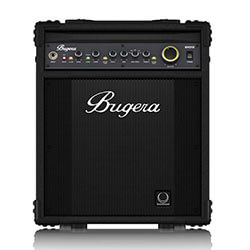
برای تمرینات، ضبط استودیویی یا اجراهای کوچک ، نوازندگان گیتار باس و الکتریک معمولا از کمبو آمپلی فایرها استفاده میکنند که از یک پری آمپلی فایر، کنترلر های تنظیم صدا، یک پاور آمپلی فایر و یک یا چند بلندگو در یک کابینت تشکیل شده است. کمبو آمپلی فایرها در تعداد بلندگو متفاوت میباشند ، که دارای انواع یک بلندگویی (معمولا دارای یک بلندگوی 12 یا 15 اینچی میباشند، اگرچه میکرو امپ هایی با یک بلندگوی 10 اینچی نیز وجود دارد) یا دو بلندگویی ( مثلا دو بلندگوی 10 اینچی) یا چهار بلندگویی ( مثلا چهار بلندگوی 10 اینچی)، میباشند .تفاوت کمبو آمپلی فایر ها با آمپلی فایرهای تمرینی در کاربرد آنها است. کمبو آمپلی فایرها را میتوان در اجرای زنده نیز بکار برد. قدرتمندترین کمبو آمپلی فایرهای موجود، بین 800 تا 1000 وات توان خروجی را به بلندگوهای داخلی انتقال میدهند.
Bass stack:
از Bass stack ها در اجراهای بزرگ مانند استادیوم یا فستیوال های موسیقی در فضای باز استفاده می شود. همچنین این نوع آمپلیفایر ها در اجرای زنده سبک های هوی متال، گرانج و هاردکور پانک که در آنها باس با دامنه پایینتر و صدای بلندتر وجود دارد نیز به کار می روند. نوازندگان باس معمولا از آمپلی فایرهای قدرتمندتر( 300 تا 2000 وات یا بیشتر) و یک یا چند کابینت مجزا در ترکیبهای متفاوتی استفاده میکنند. به یک آمپلی فایر مجزا و چند بلندگو، bass stack میگویند. نمونه ای از آمپلی فایرهای قدرتمند که در grunge بکار میرود ، آمپ مایک اینز بیسیست گروه آلیس این چینز میباشد. که از 4 هد آمپلی فایر Ampeg SVT-2PRO که دوتای آن به 4 ساب ووفر 18.1 اینچی و دوتای دیگر به دو تا 10.8 اینچی متصل اند.
هد:
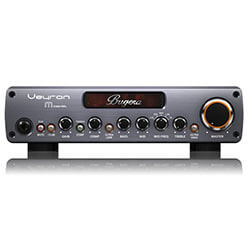
آمپلی فایرهای باس جداگانه ای که فاقد بلندگو میباشند را معمولا هد یا هد امپ میگویند. head معمولا شامل یک پری آمپلی فایر، اکولایزر( کنترل های باس و تریبل) و یک پاور آمپلی فایر میباشند .برخی از نوازندگان از تنظیمات مجزای پری آمپلی فایر/پاور آمپلی فایر استفاده میکنند، که یک یا چند پری آمپلی فایر ، یک یا چند پاور آمپلی فایر را هدایت میکنند. برای مثال یک نوازنده باس میتواند از یک bass-specific power amplifier یا sound reinforcement system power amp استفاده کند. هد آمپلی فایرهای باس در ولتاژهای قدرتمندی که در کمبو ها وجود ندارد موجودند. برای مثال هد Ampeg SVT8-PRO دارای خروجی 2500 وات است که برای بزرگترین کابینت 10*8 اینچی و مکان های بزرگ ( مانند استادیوم ) کافی میباشد.
Hybrid یا miscellaneous units:
تعداد کمی از آمپلی فایرهای باس وجود دارند که در دسته بندی آمپلی فایرهای Combo قرار نمیگرند.در برخی از آمپلی فایرهای کمبو، آمپلی فایر آنها قابلیت جدا شدن از کابینت را دارد و یک هد مجزا را در اختیار کاربر قرار میدهد. این امر موجب سهولت در حمل و نقل میشود. مثلا در ضبط استودیویی به عنوان پری امپ استفاده میشود. همچنین یک کابینت جداگانه که میتواند با هد های مختلفی مورد استفاده قرار گیرد. در برخی از هد ها یک بلندگوی کوچک تعبیه شده که صدای کافی را تولید میکند، بنابراین میتواند به عنوان یک آمپلی فایر تمرینی مورد استفاده قرار گیرد که این موضوع به نوازنده این امکان را میدهد تا زمانی که هد را بدون کابینت آن در دسترس دارد به تمرین بپردازد.
تکنولوژی آمپلی فایر
آمپلی فایر میتواند تکنولوژی لامپی (thermionic یا valve) ، یا ترانزیستوری (Solid) و یا حتی ترکیبی از این دو تکنولوژی باشد که از ترکیب یک پری آمپلی فایر لامپی و یک پاور آمپلی فایر ترانزیستوری به دست می آید که اصطلاحا Hybrid نامیده میشود.
آمپلی فایر های لامپی:
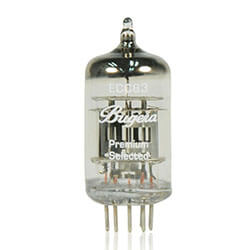
مهمترین قطعه الکترونیکی بکار رفته در آمپلی فایرهای ساخته شده در سالهای 1950 تا اوایل 1970 ، لامپهای خلا بودند، و در سالهای 2010 به بعد در کمبو آمپلی فایرها، هد آمپلی فایرها و پری آمپلی فایرهای گران قیمت از لامپ استفاده شد.( همچنین از امپ های لامپی در سیستم های استریو hifi خانگی بسیار گران قیمت نیز استفاده میشود). جهت افزایش بهره وری ، آمپلی فایرهای لامپی تقریبا همیشه از توپولوژی کلاس AB1 استفاده میکنند.
آمپلی فایرهای ترانزیستوری (solid) :
در دهه 1960 و 1970 ، آمپلی فایرهای نیمه رسانا یا ترانزیستوری (solid) محبوبیت زیادی پیدا کردند.این امر تا حد زیادی به دلیل ویژگی ها و سطح توان، قیمت ارزانتر و وزن سبکتر این آمپلی فایرها بود. همچنین آمپلی فایرهای ترانزیستوری در مقایسه با آمپلی فایرهای لامپی کمتر آسیب پذیر بوده و بسیار قابل اعتمادتر بودند.
هیبرید(Hybrid):
هد آمپلی فایرهای ترکیبی (hybrid) از یک پری آمپلی فایر لامپی و یک پاور آمپلی فایر ترانزیستوری تشکیل شده است و ترکیبی از بهترین فناوری های هر دو تکنولوژی را در اختیار نوازنده قرار میدهد. پری امپ لامپی صدای گرم تر و دلنشین تری را نسبت به پری امپ ترانزیستوری در اختیار نوازنده قرار میدهد که با وجود افزایش شدید صدای پری امپ نیز دارای صدایی طبیعی میباشد.
Bass Guitar Amplifier
A bass amplifier or "bass amp" is a musical instrument electronic device that uses electrical power to make lower-pitched instruments such as the bass guitar or double bass loud enough to be heard by the performers and audience. Bass amps typically consist of a preamplifier, tone controls, a power amplifier and one or more loudspeakers ("drivers") in a cabinet.While bass amps share many features with the guitar amplifiers used for electric guitar, they are distinct from other types of amplification systems, due to the particular challenges associated with low-frequency sound reproduction. This distinction affects the design of the loudspeakers, the size and design of the speaker cabinet and the design of the preamplifier and amplifier. Speaker cabinets for bass amps usually incorporate larger loudspeakers (e.g., 15" speakers are more common for bass than for electric guitar amps) or more speakers and larger cabinet sizes than those used for the amplification of other instruments. The loudspeakers themselves must also be sturdier to handle the higher power levels and they must be capable of reproducing very low pitches at high sound pressure levels.
The bassists who first sought methods to make their instruments louder were upright bass players. While the upright bass is a large instrument, standing about six feet tall (with its endpin extended), due to its low register it is not a loud instrument when played acoustically, as lower frequencies attenuate rapidly with distance. In the 1890s and early 1900s, upright bass players performing in bars and brothels often found it difficult to be heard by the audience over louder instruments such as trumpet. A partial solution was playing slap bass style, slapping the strings against the fingerboard to make a relatively loud percussive sound.
Types
Different types of equipment are used to amplify the electric bass and other bass instruments, depending on the performance setting, style of music, the sound desired by the bassist, the size of the venue and other factors, such as whether a bassist is an amateur or professional musician. Professional bassists are more likely to have expensive "boutique" amps and cabinets. All types of bass amps and cabinets are designed to be transportable to shows and recording studios, and as such, most have various features to protect the cabinet (e.g., metal or plastic corner protectors) and speakers (a plastic screen or metal grille) during transportation and move the equipment (a single carry handle is standard for practice amps and combo amps and two handles are sometimes provided for two-handed carrying of large cabinets, and wheels are mounted on some large combo amps and cabinets). Amplifier "heads" may be sold mounted in a wooden cabinet with a carrying handle, or they may be sold as rackmount-able components, which can be screw-mounted in a 19" road case for protection. The speaker enclosures for combo amps and speaker cabinets are typically covered in stiff vinyl, carpet, felt or other sturdy fabric, or painted.
Practice amps
The smallest bass amps, which typically have 10 to 20 watts of power and a small 6.5" or 8" speaker, are known as practice amps. They amplify the instrument enough for individual practice in a small room, such as a bedroom. Practice amps do not typically produce enough volume or low-frequency sound reproduction to be used in a band rehearsal or show. As such, they are mostly used by beginners or, when used by professionals, for warm-up or individual practice. They are more likely than full-size combo amp cabinets to have an open-back design, like an electric guitar combo amp. The use of an open back cabinet in small practice amps makes these models different from most bass combo amps and speaker cabs, which are closed-back (often with bass reflex ports or vents, or less commonly, with passive radiator speakers, both of which are designed to boost the low-frequency response). Some buskers playing on the street for tips may use battery-powered practice amps, a feature available on some models.Practice amps often have an auxiliary line-in jack, so that the bassist can plug in a recorded music signal (often via an 1/8" jack), to practice along with a recording. The line-in jack can also be used to plug a drum machine into the amp, also for practice purposes. Some practice amps have a level control knob for the line-in input. Practice amps often have a headphone jack, with a feature that turns off the power amplifier when headphones are connected. This feature enables bassists to practice silently at night, to avoid disturbing others in adjoining rooms or apartments. Higher-priced practice amps aimed at pro bassists may have a DI out jack, so that the amp's preamplifier signal can be connected directly to a mixing board for a live show's sound reinforcement system or for a sound recording session. DI out-equipped units effectively turn the practice amp into a preamplifier unit.
Combo amps
For rehearsals, studio recording sessions, or small club performances, electric and upright bass players typically use a "combo" amplifier, which combines a preamplifier, tone controls, a power amplifier and a speaker (or multiple speakers) in a single cabinet. Combo amps come in a variety of speaker configurations, such as one speaker (e.g., often one 12" speaker or one 15" speaker, although there are some micro-amps with one 10" speaker) or two speakers (e.g., two 10" speakers) or four speakers (e.g., four 10" speakers). The dividing line between practice amps and combo amps that can be used for live venue shows is described in the power in watts section. The most powerful combo amps available deliver between 800 and 1000 watts to the internal speakers.
Bass stacks
For larger venues such as stadiums and outdoor music festivals, or for music genres that use bass instruments with an extended lower range and high stage volumes (e.g., heavy metal music, grunge, hardcore punk), bass players often use a more powerful amplifier (300 to 2000 watts or more) and one or more separate speaker cabinets (often called "cabs") in various combinations. Using a separate amplifier cabinet and speaker cabinets is colloquially referred to as a "bass stack". An example of the powerful, loud bass amplifier systems used in grunge is Alice in Chains bassist Mike Inez's setup. He uses four Ampeg SVT-2PRO amplifier heads, two of them plugged into four 1x18" subwoofer cabinets for the low register, and the other two plugged into two 8x10" cabinets.[6]
Heads
Separate bass amplifiers which do not contain speakers, often called "heads" or "amp heads", are usually integrated units, with a preamplifier, equalizer (bass and treble controls) and a power amplifier combined in a single unit. Some players use separate preamplifier/power amplifier setups, where one or more preamplifiers drive one or more power amplifiers. In the latter example, a bass player can use a bass-specific power amplifier or use a sound reinforcement system power amp. Bass amp heads are available in high-wattage power ratings that are not available in combo units. For example, the Ampeg SVT8-PRO amp head puts out 2,500 watts RMS at 2 ohms, a power level that is high enough for the largest 8x10" cabinets and the largest venues (stadiums, outdoor festivals, etc.).
Hybrid or miscellaneous units
A small number of bass units do not fit into the "combo" amplifier, standalone amplifier or separate speaker cabinet categorization or typologies. Some bass amp combos have a removable amplifier. With the amplifier unit taken out of the combo cabinet, the user then has an easily portable amp head (which can be taken to a recording studio for use as a preamp, to lay down bass tracks) and a separate bass speaker cabinet, which could be used with another bass amp head. As well, some amp heads have a small built-in speaker which produces enough sound so that it can be used as a practice amp, so that the bassist can practice when she/he has the head, but not the speaker cabinet. This way, a bassist in a touring band could practice electric bass using her amp head, even if her speaker cabinets were still locked up in an equipment van.
Amplifier technology
Amplifiers may be based on tube ("thermionic" or in the UK, "valve") or solid state (transistor) technology, or hybrid designs that use both technologies, typically by pairing a tube preamplifier with a transistor power amplifer.
Tube amplification
Vacuum tubes were the dominant active electronic components in bass amplifiers manufactured from the 1950s until the early 1970s, and tubes continue to be used in the 2010s for expensive bass combo amplifiers, amp heads, and preamplifiers (as well, tube amps continue to be used by audiophiles for some expensive home hifi stereo systems). Tube amplifiers for bass almost always use class AB1 topology for efficiency reasons.
Solid state amplification
By the 1960s and 1970s, semiconductor or transistor-based amplifiers (also called "solid state") began to become popular. This was in large part because for a given wattage level and feature level, solid state amplifiers are less expensive, lighter weight, and require less maintenance than tube amplifiers. As well, transistor amplifiers are more reliable and less fragile than tube amps. In some cases, tube and solid state technologies are used together, usually with a tube preamplifier driving a solid state power amplifier. There are also an increasing range of products that use digital signal processing (DSP) and digital modeling technology to simulate many different combinations of amp and cabinets.
Hybrid
Hybrid bass amplifier heads typically pair a tube preamplifier with a solid-state power amplifier. This provides the player with the best elements of both amplifier technology. The tube preamp gives the player the ability to obtain tube amplifier tone, which tube enthusiasts state is "warmer" than a solid state (transistor) preamp. As well, tube users state that tube preamps have a more pleasing-sounding, natural tone when the preamp's volume is pushed up so high that the bass signal becomes overdriven; in contrast, a solid state preamp that is pushed to the point of signal "clipping" can be harsh-sounding. Some hybrid amp heads have a bypass switch, so that the tube preamp can be bypassed, if the tube breaks or develops a technical problem. The tube preamplified signal in a hybrid amplifier head is then sent to a solid state power amplifier. Compared with tube power amps, solid state power amplifiers are more reliable, require less maintenance, less fragile and lighter in weight. A hybrid tube preamp/solid state power amp thus provides a bass player with the benefits of both technologies' strengths: tube preamp tone and solid state reliability for the power amp.











-228x228.jpg)
-228x228.jpg)
-228x228.jpg)
-228x228.jpg)

-228x228.jpg)
-228x228.jpg)
-228x228.jpg)
-228x228.jpg)
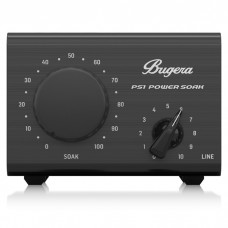
-228x228.jpg)
-228x228.jpg)
